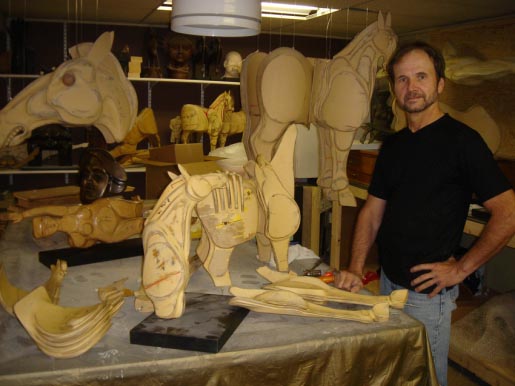![]()
Sculptor shows fantastic horses at SOFA SOFA, EXPOSITION OF SCULPTURE, OBJECTS AND FUNCTIONAL ART SOFA, now in its 15th year, is presenting works by emerging and established artists and designers for sale by 100 galleries and dealers from 16 countries. Among those displaying their work is Jözef Sumichrast of Lake Forest. Sumichrast is a fine art sculptor who works in bronze and compressed cardboard and is represented by Flatfile Gallery in Chicago. It may come as a surprise to his customers to know that the majority of the materials he works with are purchased from building supply centers or hardware stores. In his sculptures of horses, Sumichrast explores the nature of seeing, organic form, and sculptural materials. The artist knows horses, for he rides them in the Pacific Ocean on family vacations at remote Mexican beaches. His pedestal-sized sculptures seem buoyant and some are legless because he often visualizes horses in the water where they swim like dogs. As horses emerge from the ocean, they roll on their backs in the sand to dry off. To avoid being crushed, the rider must dismount quickly. Sumichrast makes his sculptures from layers of flat, rounded forms that recall natural elevations and depressions in topographic maps. Hi gives smaller parts of the horse, such as knees, ankles, and cheeks, a near-mechanical appearance. This strategy distances the work from figuration. “My sculptures are not a horse”, he says. “ They convey the essence of a horse”. The artist says that his work “explores the relationship between the second, third, and fourth dimensions.” He employs flat dimensional forms to “minimize a part of the sculpture or to show its basic shape” and uses the third dimension to emphasize a particular part of the piece. He bends or twists many sculptures to show the viewer more than one angle at a time. Instead of “freezing” angles and presenting them to the viewer as Picasso does in his Cubist sculptures, Sumichrast expects the viewer to take a more active role by looking “around the corners” of his work. Light and viewer participation give the sculpture “it fourth dimension,” he says. The artist started out as a draftsman and graphic designer, became a painter, and then took up sculpture. Each new sculpture begins with a rough sketch, which he develops into a formal scale rendering with a constant horizon like architectural elevations and plan views. Next, he cuts out forms from dense industrial cardboard, saturates them with carpenter’s glue, and wraps them around a pipe or other cylindrical object to curve them. The cardboard forms harden to a condition like plastic. When he has an inventory of curved forms, the artist begins to glue or staple them together. Once he has completed the sculpture in cardboard, he covers it with Bondo, which is the trade name for a pale butter yellow polyester resin putty that auto body shops use to repair dents. Sumichrast applies the Bondo with a putty knife, lets it harden, and sands it down to uncover the edges of the cardboard forms beneath and to intensify the sculpture’s linear quality. Some sculptures have red lines ion the surface, which function as accents. “Red suggests pain to me”, the artist says. “I’m always cutting and scraping my hands as I work. One day I got mad at the sculpture and decided to cut back by leaving a red line on its surface.” Ann Host, Carol Fox & Associates, Inc.
|

